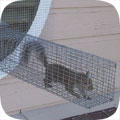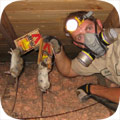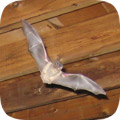- lagrange@wildlifeanimalcontrol.com
Call 24/7 for a free quote:
979-404-2935
La Grange Wildlife Animal Control
Professional Wildlife Removal Company Servicing La Grange, TX
If you have a problem with wildlife in your La Grange home, your best option is to hire a company that specializes in Texas wildlife removal only. This is a specialty business, and regular pest control companies do not use the proper techniques to solve animal problems. I have spent many years reviewing Texas and La Grange, and I recommend the following:
Professional Wildlife Services
Cell Phone: 979-404-2935
NOTE: If you have a dog or cat problem, call Fayette County Animal Services: (979) 966-0021

Professional Wildlife Services specializes primarily in removing animals from attics of homes and buildings - this includes squirrels in attics, raccoons, and rats or mice in homes. Texas also has a documented problem with
bats in buildings, and Professional Wildlife Services is specially trained in bat removal. They also perform general wildlife trapping services, such as the capture and removal of skunks or opossums on the
property. Call 979-404-2935 to discuss your critter problem and schedule a same-day or next-day appointment. Click here to learn more about
what prices we charge in 2025.
When hiring a company to solve your wild animal problem, you want these features:
- Specializes in wildlife removal, not pest control
- Fully Texas and Fayette County licensed and insured
- Works 7 days per week (critters don't take weekends off)
- Performs full building inspections: enters and inspects attic
- Performs exclusion repairs, with guarantee against animal re-entry
- Offers cleanup of biohazardous wildlife waste
Professional Wildlife Services is a full-service La Grange wildlife removal company. This is very different from a regular La Grange pest control company. The pest control companies spray poison to kill insects. This is not at all
similar to wildlife removal. Professional Wildlife Services performs a full inspection of the home or property, and determines why the animal(s) are there, and if inside a building, how the animals got inside. All
animals (including rodents) are trapped and removed, or if possible, removed from the building using special exclusion devices. Once the animals are gone, preventative repairs are essential, and
cleanup is sometimes recommended.
 La Grange wildlife trapping - it's not as simple as it may seem. It's illegal in Texas to trap without a license. Trap type is very important and there are many different types, bait is somewhat relevant, trap placement
is vital, and there are dozens of small things that are very important to know.
Safety is a concern. Then once the animal is trapped, it must be removed and dealt with in the proper manner according to Texas law. We offer La Grange raccoon removal. Read more about how to get rid of raccoons.
La Grange wildlife trapping - it's not as simple as it may seem. It's illegal in Texas to trap without a license. Trap type is very important and there are many different types, bait is somewhat relevant, trap placement
is vital, and there are dozens of small things that are very important to know.
Safety is a concern. Then once the animal is trapped, it must be removed and dealt with in the proper manner according to Texas law. We offer La Grange raccoon removal. Read more about how to get rid of raccoons.
 Animals in attics - this is our specialty at Professional Wildlife Services. Many types of animals like to live in attics. This includes squirrels, raccoons, rats, mice, bats, birds, and even possums. Critters like to go into attics for a safe place to live
and raise their young. Removing animals from attics is very complex work, partly because of the presence of baby animals. If you need La Grange squirrel removal, we can remove all the squirrels from your attic, and seal out any future ones. Read more about how to get rid of squirrels.
Animals in attics - this is our specialty at Professional Wildlife Services. Many types of animals like to live in attics. This includes squirrels, raccoons, rats, mice, bats, birds, and even possums. Critters like to go into attics for a safe place to live
and raise their young. Removing animals from attics is very complex work, partly because of the presence of baby animals. If you need La Grange squirrel removal, we can remove all the squirrels from your attic, and seal out any future ones. Read more about how to get rid of squirrels.
 Rodent control must be done in a very specific way. First off, the most important thing is that all the openings that rats and mice can use to enter a house be sealed. Then all the rodents must be physically trapped and removed.
Never, ever use poison! Most La Grange exterminators will just use this lazy poison technique to kill rodents, and it causes more harm than good - dead stinky rats, and it doesn't solve the problem. Call us for correct La Grange rat removal. Read more about how to get rid of rats.
Rodent control must be done in a very specific way. First off, the most important thing is that all the openings that rats and mice can use to enter a house be sealed. Then all the rodents must be physically trapped and removed.
Never, ever use poison! Most La Grange exterminators will just use this lazy poison technique to kill rodents, and it causes more harm than good - dead stinky rats, and it doesn't solve the problem. Call us for correct La Grange rat removal. Read more about how to get rid of rats.
 Bat removal is a highly specialized task. Texas is known to have colonizing bats who often live in buildings. Bats love attics. If not removed, the colony can grow to a very large size over the years. The bat droppings are often corrosive and
cause health risks. The same goes for bird droppings on or in buildings. We perform La Grange pigeon removal and bird control. But our specialty is La Grange bat removal. We remove 100% of the bat colony and seal the building so that it's totally bat-proof. Read more about how to get rid of bats.
Bat removal is a highly specialized task. Texas is known to have colonizing bats who often live in buildings. Bats love attics. If not removed, the colony can grow to a very large size over the years. The bat droppings are often corrosive and
cause health risks. The same goes for bird droppings on or in buildings. We perform La Grange pigeon removal and bird control. But our specialty is La Grange bat removal. We remove 100% of the bat colony and seal the building so that it's totally bat-proof. Read more about how to get rid of bats.
 If you have animals inside a house, no job is complete without proper exclusion repairs. If you simply hire a La Grange trapper who only removes the critters, then the problem will return. You need to hire a La Grange wildlife control company that identifies 100% of the animal entry points
into your building, and seals them shut with professional repairs. In addition, in many cases animals have left waste or contamination behind, and you'll want a company that can provide professional cleaning services. Professional Wildlife Services does both.
If you have animals inside a house, no job is complete without proper exclusion repairs. If you simply hire a La Grange trapper who only removes the critters, then the problem will return. You need to hire a La Grange wildlife control company that identifies 100% of the animal entry points
into your building, and seals them shut with professional repairs. In addition, in many cases animals have left waste or contamination behind, and you'll want a company that can provide professional cleaning services. Professional Wildlife Services does both.
The above are just some of the services offered by Professional Wildlife Services. We also trap and remove animals that destroy lawns, such as moles, or digging animals. Sometimes animals like opossums will live under buildings, steal pet food, raid garbage cans, etc.
Read about how to get rid of opossums. Skunks commonly live under sheds or decks, and set up a den. We can trap and remove them without them spraying. Read about how to get rid of skunks. Professional Wildlife Services
also provides dead animal removal in La Grange. If you need help with any other wildlife conflict, from a fox, beaver, groundhog, or any other critter, we can solve it. We also do La Grange snake removal - most of the snakes in Texas are not venomous, but
call us if you want safe removal, or read about how to get rid of snakes in La Grange. And remember, we are a private business, not Fayette County Animal Control Services, so if you have a dog or cat problem, call the County at (979) 966-0021.
Fayette County animal services does not handle any wildlife issues.
Professional Wildlife Services
Cell Phone: 979-404-2935
La Grange Pricing Info
Every wildlife removal situation is different, from the species of animals involved, the location of the animal inside a house or outside, the extent of repairs or cleanup, etc. It's impossible to give one-size-fits-all prices. Examples MIGHT include:Small Job: For example, a one-stop job to remove an animal in the yard: $100 on up
Medium Job: For example, getting critters out of your house with minor repairs: $300 on up
Large Job: For example, a project involving many service trips and complex work: $500 on up
Give us a phone call now and tell us about your wildlife issue and we will be able to give you a price estimate over the phone. If you're cool with it, we can schedule a same-day or next-day appointment if you like. Our prices are fair, and a good value because we do the job right, the first time.
La Grange Wildlife Tip #1:
The corn snakes: Appearance, Biology, Life Cycle, Habitat, Diet and Behavior
The corn snakes are the special specie that is quite popular in North America, the United States and the southeastern America. Most people know about this snake and love it for the calm and attractive nature. The look of the corn snakes are what made most people to think that they are among the venomous snakes whereas they are just harmless. They are not quick to bite and have quite beautiful look which made most people to even consider keeping them as pet. You will learn more about these snakes through this article.
The Appearance
The corn snakes have unique nature and appear with different colors. Comparing with the copperhead snakes the corn snakes have far more attractive body. Full grown corn snakes measure 61-182 cm in length. They equally have brighter color, humble nature as well as slender look. These are the possible attributes that distinguished corn snakes from the copperhead snake. So, it is important you know more about these snakes so as to avoid killing a harmless and non-aggressive corn snake.
Biology and Life Cycle
The class of corn snakes is reptilia Chordata and they are quite easy to breed. During the time of reproduction corn snakes normally enter into the cooling period which normally last for about sixty to ninety days. When they want to lay eggs, they normally select places calm and serene places as well as places free from direct sunlight. Their breeding seasons normally start as soon as winter is over. The corn snakes have amazing life cycle and can easily live in the wild for up to six to eight years. They can equally live up to twenty years while in captive and cared for at home as pet.
Habitat and Diet
In the normal way, corn snakes usually live in places with overgrown field, forest, on top of trees and wall as Flatwoods, farmlands and abandoned buildings. The adult corn snakes normally prefer leaving on the trees to as high as 6000 feet. Nevertheless, where the snakes leave is usually determined by season. They usually hibernate during the winter and take refuge in rocks in temperate climate. During the winter they do not hunt much as they always need heat from sunlight more than food so as to ensure they get enough warmth that will help them survive. Corn snakes are equally known to be carnivorous in nature but do not eat as much as copperhead snakes. They prefer to live on mice, bird eggs, other reptiles, amphibians and others.
The Behavior
For the behavior the corn snakes are truly amazing with their special striking behavior. In fact the manner in which these snakes strike are among the reason why people prefer to keep them as pet. They have interesting temperament, easy going behavior, soft nature and others. They love to stay inside burrows and places without any form of disturbance. They are subtle and prefer to eat pre-killed meat and other meats that are heavily injured.
La Grange Wildlife Tip #2:
Texas Wildlife Information:
Texas State bird: Northern mockingbird
State mammal: Nine-banded armadillo, Texas longhorn, Mexican free-tailed bat
State reptile: Texas horned lizard
State amphibian: Texas Toad
State fish: Guadalupe bass
State insect: Monarch butterfly
Texas, the second largest state in the United States, has multiple climate regions, and thus very unpredictable weather patterns. Not only can Texas have tornados, it can be hit with devastating hurricanes or extended periods of drought. West Texas often sees snow, whereas East Texas is almost always hot and dry. Some areas receive ample rain; some areas receive none. All of this variability means any animals living in Texas need to be ready for just about anything.
The regions in Texas where vegetation is scarce and the sun beats down are the prime locations for the many different lizard species living in the state. Of those, the Texas horned lizard spends its days eating the ample supply of ants which also thrive in the dry environment. The desert tortoise also likes to spend time out in the sun, eating prickly pear fruit. Unfortunately, these critters who love to be out in the open are often prey to one of Texas's largest nuisance animals, the coyote. More a bane to farmers, coyotes are opportunistic creatures, smart enough to evade capture and devious enough to break through inadequate fencing. Other large Texas predators, like the cougar and the bobcat, tend to be leery of people, spending most of their time in the scrub forests surrounding rivers like the Rio Grande.
A lack of large predators does not give the state any break from nuisance animals, however. Just like other, smaller states, Texas has significant issues with rodent infestations, including that of rats, mice, and squirrels. Another small animal pest, though not a rodent, is the Mexican free-tail bat, a common creature in the Texas skies at dusk. Bats love to take up residence in attics around the region, and because most areas in Texas are mild during the winter months, the bats will remain all year.
Armadillos also make their presence known in yards around the state. Texas is naturally dry, and a lush yard, which is likely irrigated, will hold a much more enticing amount of bugs for the armored critter. An armadillo can do serious damage to a yard in just one night. If that's not enough, Texas has a good number of both venomous and non-venomous snakes, all of which will be drawn to places with water supplies; aka: pools and ponds.
You can always call Professional Wildlife Services, any time of day, at 979-404-2935, for a price quote for La Grange wildlife control services. I am confident that this is the best choice amongst wildlife removal companies in La Grange, TX.







































